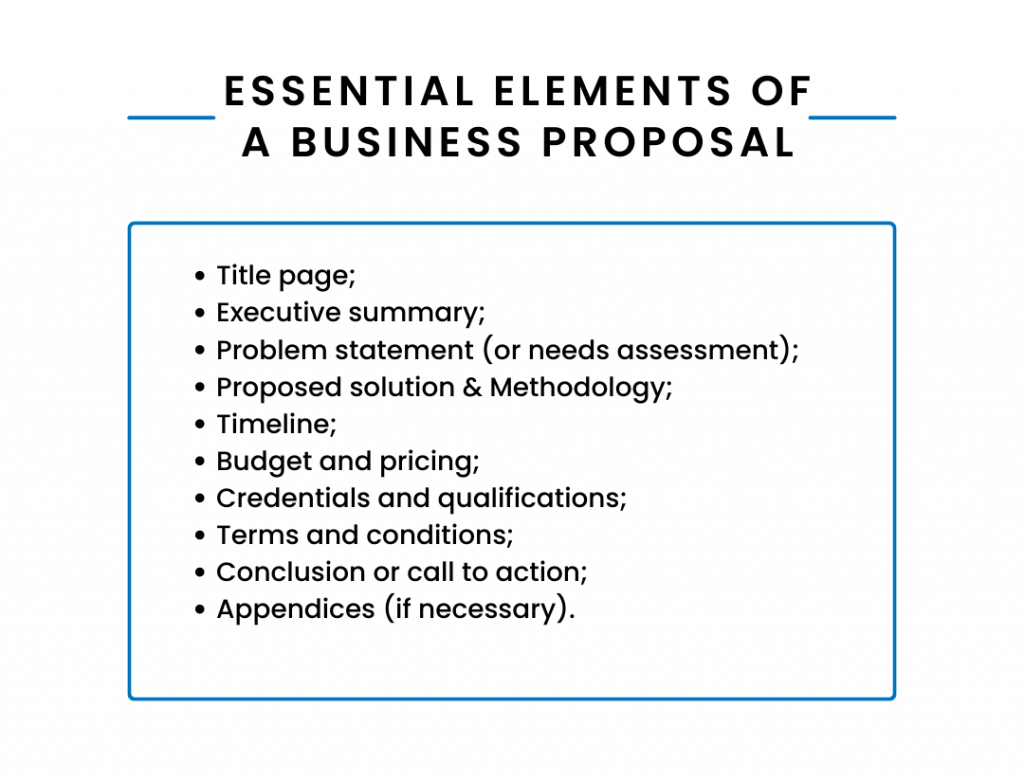In the realm of business, your ability to persuade potential clients can often hinge on a well-crafted business proposal. Such a document can make or break a deal. This article is a comprehensive guide that will not only discuss the core components of a business proposal but also provide you with a practical business proposal template to use as a starting point.
Contents:
1. Understanding the purpose of a business proposal
2. Why is a business proposal important?
3. Types of business proposals
4. Essential elements of a business proposal
5. How to write a business proposal step by step [+ a free template]
6. Enhancing your business proposal
Understanding the purpose of a business proposal
A business proposal is a formal document that businesses use to persuade or inform a potential client or buyer about specific goods, services, or solutions they offer. It aims at convincing the recipient to engage in a business arrangement or transaction with the sender. Typically, a business proposal outlines a particular problem or need faced by the client and then presents a detailed solution provided by the proposer’s business, outlining the benefits, costs, timelines, and other relevant details.
Why is a business proposal important?
A business proposal is a foundational document in the world of commerce, and its importance can’t be overstated for several reasons.
Business proposal showcases professionalism
A well-crafted proposal signifies a company’s professionalism, organization, and commitment. It gives the prospective client confidence that the business is competent and serious about the project.
Business proposal clarifies offerings and expectations
A proposal clearly outlines what services or products will be provided, how they’ll be delivered, and the terms of engagement. This clarity reduces ambiguity, which can lead to misunderstandings or disputes down the line.
Business proposal demonstrates understanding
Through a proposal, a business can show that it understands the client’s needs, challenges, and objectives. This understanding fosters trust and rapport between the business and the potential client.
Competitive differentiation
A well-thought-out proposal can set a business apart from its competitors. It offers an opportunity to showcase unique solutions, expertise, and value, making a compelling case for why a client should choose one business over another.
Business proposal acts as a persuasive tool
At its core, a business proposal is a persuasive document. It aims to convince the potential client that the proposing company is the best fit for the job, based on its expertise, approach, and understanding of the project.
Business proposal facilitates decision-making
For clients comparing multiple vendors or solutions, a clear and detailed proposal can be instrumental in the decision-making process. It provides all the necessary information in one place, aiding in the evaluation and selection process.
Business proposal provides legal protection
In some cases, a business proposal can serve as a contractual document or be integrated into one. As such, it provides a record of what was agreed upon, which can be referred to in case of disagreements or legal disputes.
Business proposal builds the foundation for the project
Once accepted, the proposal acts as a roadmap for the project’s execution, guiding deliverables, timelines, responsibilities, and more. It establishes a shared vision and understanding between the business and the client.
Types of business proposals
Business proposals can be categorized based on various factors, including their purpose, solicitation process, and the nature of the offering.
Solicited business proposals
- Formally solicited. These are proposals requested through an official channel, often in response to a “Request for Proposal” (RFP), “Request for Quotation” (RFQ), “Request for Information” (RFI), or “Invitation for Bid” (IFB). The client provides a specific document detailing their needs and requirements.
- Informally solicited. These proposals are solicited, but not through formal means. They usually arise from casual conversations between a business and its potential client.
Unsolicited business proposals
These are akin to cold calls. The business identifies a potential client and sends a proposal without them explicitly requesting it. The aim is to surprise the potential client with a solution they might not have realized they needed.
Continuation proposals
These are about ongoing projects. When a project is part of an ongoing contract, a continuation proposal describes the status of the project, what has been achieved so far, what is yet to be done, and how the existing project plan might be adjusted based on progress and learnings.
Renewal proposals
When an existing contract or agreement is about to terminate, a renewal proposal is presented to reiterate the success of the ongoing arrangement and to propose a continuation or renewal of the contract.
Supplemental proposals
These are presented when additional resources are needed for a project beyond what was initially anticipated. The proposal will justify the additional resources and describe the potential consequences if the resources aren’t granted.
Internal and external proposals
- Internal proposals. Aimed at decision-makers within the organization, such as department heads or executives. They often focus on resource allocation, approvals for projects, or internal solutions.
- External proposals. Directed at external entities, either another business, organization, or individual. They typically offer products, services, or solutions.
Pre-proposal (Letter of inquiry)
This is a shorter, more concise version of a proposal sent to see if there’s interest in a more detailed proposal. If the potential client or grant committee is interested based on the pre-proposal, they’d request a full proposal.
Grant proposals
These are written to secure grant funds from private foundations, government, or other entities. They are highly structured with specific sections and criteria to meet, focusing on a project’s objectives, significance, methods, personnel, budget, and other relevant details.
Each type of proposal has its unique challenges and requirements, but they all aim to persuade the recipient to take action. Understanding the type and nature of a proposal can guide businesses in structuring their proposals more effectively and targeting them to the right audience.
Essential elements of a business proposal
The essential elements of a business proposal ensure that it’s comprehensive, persuasive, and clearly communicates its intended message. Here are the main elements to include in the business proposal (we’ll get into more detail in the next section):

Remember, the design and layout of your proposal also matter. A well-organized, visually appealing proposal can make a significant difference in how your content is received.
Proposal template for a business: How to write a business proposal step by step [+ a free template]
Understand the client’s needs
Begin by familiarizing yourself with the client’s industry, challenges, competitors, and goals. If you’re responding to an RFP, it’s essential to read all the materials they’ve provided thoroughly. If there isn’t an RFP, consider setting up a meeting or a call with the potential client to discuss their specific needs and expectations.
Determine the scope of work
Clearly define what you’ll be delivering, considering the project’s boundaries and your deliverables. It’s crucial to provide a clear timeline and specifics about each project phase or milestone.
Start with a title page
Your title page should feature your company’s name, logo, the proposal title, the client’s name, and the date of the proposal.
Write an executive summary
This is an overview of your proposal, where you should highlight the main solutions and benefits you’re offering. It’s essential to address the client’s needs and the value proposition of your solution here. It should captivate the reader’s attention and make them want to delve deeper into the document.
Detail the problem statement
Here, you’ll want to describe the issue or challenges the client is facing. A well-researched problem statement demonstrates your understanding of the client’s situation and sets the stage for your proposed solution.
Present your solution
Outline how your product, service, or approach will address the client’s problem. Emphasize the benefits, especially how they relate to the client’s specific needs. Also add a description of how you plan to carry out the project or implement the solution. This can include steps, phases, or a detailed approach, depending on the complexity of the proposal. You can use an AI presentation maker to streamline this process.
Provide a timeline
Break down the project, showing its different phases or milestones. Each phase should come with an estimated completion date. It provides the client with an idea of the project’s duration and key phases.
Detail pricing, costs, and terms
Offer a clear breakdown of all costs involved. Be as transparent as possible to avoid misunderstandings later. Also, make sure to mention any terms and conditions, such as payment terms or confidentiality agreements. It’s essential to be transparent and detailed to avoid misunderstandings later.
Add credentials and qualifications
Talk about your team’s expertise, experience, and credentials. Include details like past project successes, relevant experience, testimonials, awards, or any other credentials that highlight your expertise and reliability.
Discuss potential challenges
Be upfront about any potential obstacles or risks tied to the project. Also, provide insights on how you plan to address or mitigate these challenges. Demonstrating this kind of foresight can be very reassuring to a potential client.
Include a Call-to-Action (CTA)
Clearly guide the client on what they should do next. A strong closing that reiterates the benefits of your proposal and often urges the client to take the next steps, whether that’s a meeting, a signing, or another form of commitment.
Add supplementary information (Appendices)
Sometimes, you might have additional data or references that support your proposal but could overwhelm the main content. This information, whether it’s detailed specs, extended case studies, or terms and conditions, can be added in an appendix together with a business case template.
Review and edit
Always proofread your proposal for grammar, spelling, and clarity. Make sure client-specific information is accurate. It’s a good idea to have a colleague or another third party review the proposal, as they might catch something you missed.
Add a professional touch
Stick to a consistent and readable font throughout your proposal. Visuals, such as charts or images, can enhance the presentation. If you’re submitting a physical copy, consider using high-quality paper and perhaps professional binding.
Send the proposal
When sending your proposal electronically, use universally accessible formats like PDF. If you send out proposals regularly, proposal software that tracks client interaction with your document can be invaluable.
Enhancing your business proposal
Personalize your proposal
Tailor your proposal to the specific needs and interests of the client. Avoid using a generic, one-size-fits-all approach. Research the client’s industry, history, and challenges to show genuine understanding and care.
Use clear and concise language
Avoid jargon and complex sentences. Your proposal should be easy to understand, with each section flowing logically into the next.
Incorporate visual elements
Graphs, charts, infographics, and images can break up text-heavy sections and make data more digestible. They also add a professional touch to your document.
Start with a strong executive summary
Many decision-makers might only read the executive summary before deciding if they’ll delve deeper. Make it compelling, concise, and clear about the value you’re offering.
Include testimonials and case studies
Credible testimonials or detailed case studies can build trust by showcasing previous successes and satisfied clients.
Ensure logical flow
Structure your proposal so that it leads the reader seamlessly from identifying the problem, through the solution, to the desired outcome.
Offer multiple options
If applicable, provide tiered solutions or packages, allowing clients to choose a solution that best fits their budget and needs.
Be transparent with pricing
Break down costs clearly and explain the value behind each line item. Avoid hidden fees or vague pricing.
Follow up
After sending your proposal, schedule a follow-up call or meeting to address any questions, clarify points, or further discuss the proposal’s details.
After sending the proposal
After sending out a business proposal, it’s vital to remain proactive in your approach. Shortly after dispatching it, send a confirmation email to the recipient to ensure they’ve received and accessed the document. A week or so post-submission, it’s a good idea to touch base with a follow-up call or email. This isn’t just about nudging them; it’s an opportunity to address questions, clarify details, and engage in further discussions. Always be poised for these deeper conversations. Remember, the proposal is just a starting point, and open dialogue can often refine the offering and terms to suit both parties better.
Feedback, whether positive or negative, is gold. If the client has reservations or constructive criticism, take it in stride. Such insights can sharpen your proposal skills and increase your chances of success in future pitches. Regardless of their response, whether they’re on the fence or have concerns, maintaining a consistent tone of professionalism is essential. Your behavior during this phase can heavily influence their final decision.
If your proposal garners interest, make sure you’re clear about the next steps. This could range from formalizing the agreement with a contract to setting up an initial project meeting. Conversely, if the proposal isn’t accepted, it’s a chance for learning. Ask why, and use this feedback as a learning tool for subsequent proposals..
Lastly, always be prepared for the best outcome. If your proposal gets the green light, have all the necessary steps in place to kick off the project without delay. It’s all about transitioning from the proposal phase to the execution phase seamlessly.
Importance of utilizing business proposal templates: Conclusion
A business proposal is more than just a document; it’s a testament to your company’s ability to deliver. It’s a fine balance between being informative and persuasive. With the guidance and examples provided above and the dedicated business proposal template, you are equipped to craft proposals that not only resonate with potential clients but also position you as their preferred solution provider. Remember, every proposal is a learning experience, refining and honing your skills for future success.


![Business Proposal Template: Steps to Write a Good Business Proposal [Free Templates]](https://synder.com/blog/wp-content/uploads/sites/5/2023/08/business-proposal-template-800x500.png)



